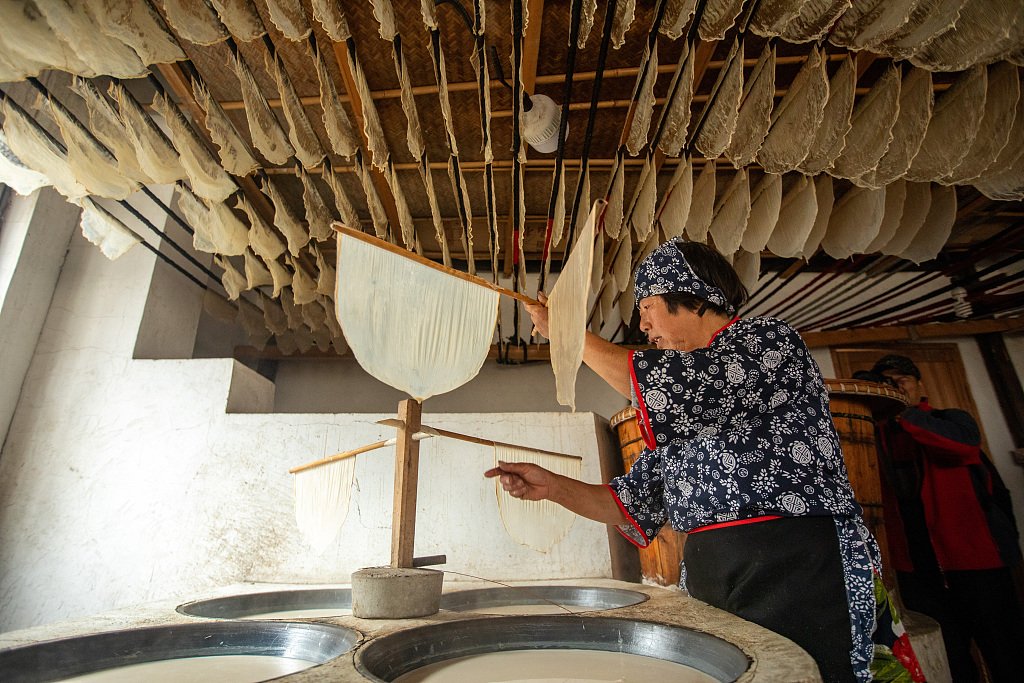In the quaint Xucun Village of Jinhua, nestled within the Zhejiang Province, an ancient culinary art is kept alive with remarkable dedication and skill. As winter unfurls its chilly embrace, the local residents engage in the traditional craft of making tofu skin, a practice steeped in history and cherished as a vital part of their cultural heritage. This artisanal process, rooted in centuries of knowledge and technique, highlights not only a unique culinary product but also the enduring spirit of the community.
Tofu skin, known locally as ‘fuyu,’ is a delicacy derived from soy milk, a staple ingredient in East Asian cuisine. The process of making tofu skin in Xucun is as poetic as it is intricate. It begins with the preparation of soy milk, extracted from locally grown soybeans that are renowned for their quality. This milk is then gently heated in traditional earthen stoves, a method that has been passed down through generations. As the soy milk simmers, a thin layer forms on the surface – this is the nascent tofu skin.
The creation of tofu skin requires not just patience but also a deft touch. The villagers, many of whom have learned the craft from their elders, skillfully lift this delicate layer using a bamboo stick. The skin, ethereal and gossamer-thin, is then carefully hung on ropes to air-dry. This drying process is crucial, allowing the tofu skin to develop its unique texture and flavor.
The tofu skin of Xucun Village is celebrated for its exceptional quality. It is as thin as a cicada’s wing, yet possesses a resilience akin to tendons, striking a perfect balance between delicacy and strength. When tasted, it reveals a subtle sweetness, a testament to the quality of the soybeans and the skill involved in its making. The texture and flavor of Xucun’s tofu skin have made it a highly favored ingredient, sought after by both local connoisseurs and discerning consumers beyond the village.
The tradition of tofu skin making in Xucun is more than just a culinary practice; it is a living link to the past. Over 70 percent of the village’s residents are adept in this ancient technique, ensuring its transmission to future generations. This widespread knowledge speaks volumes about the community’s commitment to preserving their cultural identity and heritage.
Moreover, the process of making tofu skin is deeply intertwined with the village’s social and economic fabric. It fosters a sense of community and continuity, as neighbors gather to partake in this winter activity, sharing stories and skills. Economically, tofu skin production is a source of pride and sustenance, contributing to the village’s livelihood and keeping the local agricultural practices relevant and viable.
In conclusion, the art of making tofu skin in Xucun Village is a vivid illustration of cultural preservation and culinary excellence. It embodies the rich tapestry of traditional Chinese food practices, showcasing how a simple ingredient like soy milk can be transformed into a product of delicate beauty and flavor. Visitors to Xucun are not just treated to a taste of this exquisite product; they are offered a glimpse into a way of life that honors the past while continuing to resonate in the present. The tofu skin of Xucun stands as a symbol of the village’s enduring spirit, its connection to the land, and its commitment to carrying forward a legacy that has been nurtured for several centuries.
READ MORE:
